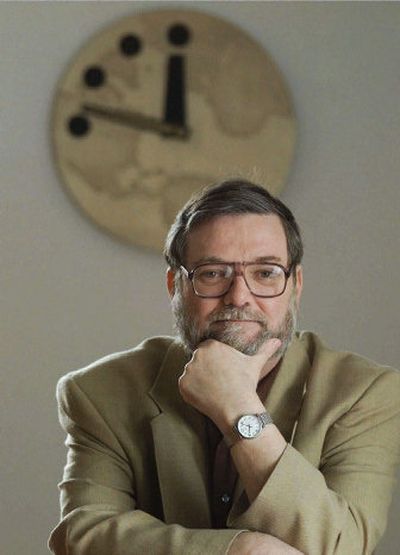Doomsday Clock moving closer to midnight?

CHICAGO – It is one of the best-known symbols of the Atomic Age: a simple clock with only the last quadrant marked, whose hands are moved forward toward midnight (indicating nuclear disaster) or back (meaning global harmony).
The Doomsday Clock hangs inside a tiny room on the University of Chicago campus, a short walk from the laboratory that first harnessed the power of the atom.
Every time a new threat to international security occurs – such as North Korea’s announcement last week that it had carried out a successful underground nuclear test – the clock’s academic guardians are bombarded with a simple question.
Is it time to move the clock again?
“The phone has been ringing off the hook,” said Kennette Benedict, executive director of the Bulletin of the Atomic Scientists, an academic journal whose founders created and oversee the clock. “It’s the public, the press and people who pay attention and are concerned about nuclear proliferation.”
Since it first appeared on the Bulletin’s cover in 1947, the clock has been moved forward or backward 17 times as events have heightened or lessened the probability of a nuclear war.
Originally, the clock was set at 11:53. Al-though initially that time was selected for aesthetic purposes, it took on broader cultural significance during the Cold War – that humanity steadily was marching toward its own destruction.
The clock came about in the 1940s amid discussions by an international team of chemists and physicists who had worked on the Manhattan Project, a U.S. government effort that developed the atomic bomb. After nuclear bombs were dropped on Hiroshima and Nagasaki in Japan, the group began meeting in Chicago.
Calling themselves the Chicago Atomic Scientists, the men began publishing a mimeographed newsletter in 1945.
Two years later, with a growing readership in the academic and scientific communities, they expanded the newsletter into a magazine. Artist Martyl Langsdorf, whose husband worked on the Manhattan Project, produced a clock for the first issue’s cover artwork to reflect urgency and warning.
The journal later commissioned the creation of an actual clock face – minus the mechanics – to hang inside the Bulletin’s offices.
The last time the clock hands were moved was February 2002. The magazine’s board of directors – a team of political scientists, nuclear physicists and retired military officials – decided that the Sept. 11, 2001, terrorist attacks and anthrax crisis were a global wake-up call.
There is no formula to gauge when or how much the hands will be moved, said Benedict. The decision is made by a consensus of the Bulletin’s board of directors, which includes sociological authorities, policy experts and former military leaders.
The journal’s separate board of sponsors, who offer technical expertise, also weigh in. Today, 11 of the Bulletin’s 38 sponsors are Nobel Prize winners.
In 1953, shortly after the United States and the former Soviet Union successfully tested hydrogen bombs, the clock was moved to its most alarming time: two minutes until midnight.
The most hopeful sign came in 1991. As the United States and the Soviet Union signed the Strategic Arms Reduction Treaty and political leaders announced additional unilateral cuts in tactical and strategic nuclear weapons, the clock hand was moved back to 17 minutes before midnight.
Some academic skeptics dismiss the clock as anachronistic and see the journal’s dwindling circulation – down to 10,000 subscribers from a peak of 35,000 in the early to mid-1980s – as proof of the icon’s relevance fading with the end of the Cold War and the downsizing of superpower nuclear arsenals.
But the magazine’s staff and believers in the Doomsday Clock insist it will remain a powerful symbol as long as nuclear, biological, environmental and other threats to humanity exist.
In November, when the 21-member board of directors gathers here for its biannual meeting, North Korea will be a focus of the two-day discussion. So will the Middle East and Asia.
If the clock hands are to be moved again, a decision could be announced in the next few months, said Seth H. Grae, a member of the board of directors.
“We’re not here to politic. We’re here as a scientific reality check,” he said.